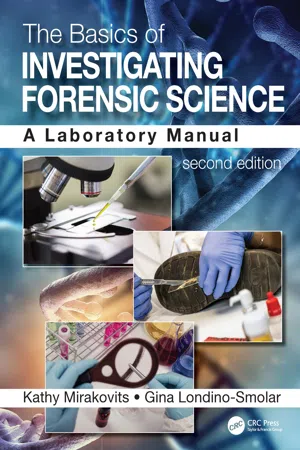
The Basics of Investigating Forensic Science
A Laboratory Manual
- 200 pages
- English
- ePUB (mobile friendly)
- Available on iOS & Android
The Basics of Investigating Forensic Science
A Laboratory Manual
About This Book
The Basics of Investigating Forensic Science: A Laboratory Manual, Second Edition presents foundational concepts in forensic science through hands-on laboratory techniques and engaging exercises. The text offers numerous lab projects on a range of subjects including fingerprinting, shoeprint analysis, firearms, pathology, anthropology, forensic biology and DNA, drugs, trace evidence analysis, and more.
This Second Edition is fully updated to include extensive full-color photos and diagrams to reflect current best-practices focussing on laboratory procedure, techniques, and interpretation of results. Each laboratory illustrates processes and concepts, and how the equipment should be set up for a given exercise. Many of the exercises can be done with minimal laboratory equipment and material while certain exercises also have additional options and advanced lab exercises—for those education institutions with access to more specialized or advance laboratory equipment. While the sequencing of laboratory exercises in the book is designed to follow The Basics textbook, the lab exercises are intentionally modular can be performed in any sequence desired by an instructor.
The Basics of Investigating Forensic Science, Second Edition is an excellent resource for introduction to forensic sciences courses, including the companion textbook it was designed to accompany, Forensic Science: The Basics, Fourth Edition (ISBN: 9780367251499). The book can be used alongside any textbook, and even serve as a stand-alone text for two- and four-year college programs, as well as course at the high school level.
Frequently asked questions
Information
Unit 1
Forensic Science and Crime Scene Investigation
Lab 1
Introduction to Crime Scene Investigation
1.1 Introduction
1.2 Pre-Laboratory Questions
- What is a protocol?
- Why is a protocol necessary in problem solving?
- Why is it beneficial to have more than one person investigating a crime scene?
- Is following a procedure unique to crime scene investigation? Explain.
1.3 Scenario
1.4 Materials
- Puzzle in a box
- Pencil or pen
1.5 Procedure
- Before beginning the exercise, discuss the methods that can be used to solve a puzzle. Design a plan that the team will use to complete the puzzle. Record the plan in Section 1.7, Part A.
- As you put the puzzle together, discuss as a team how completing the puzzle is similar to investigating a crime scene. List these in Worksheet 1.7, Part B.
- As you put the puzzle together, discuss as a team how completing the puzzle is different from investigating a crime scene. List these in Worksheet 1.7, Part C.
- After completing the puzzle, review any problems or changes to the plan that had to be made. List these in Worksheet 1.7, Part D.
1.6 Follow-Up Questions
- Class discussion: Share your team’s plan, changes to your plan, and the similarities and differences in crime scene investigation with the class.
- Complete the Venn diagram.
1.6.1 Venn Diagram

- In this exercise, solving a puzzle is compared to investigating a crime scene. Comment on the similarities and differences between what was done in the activity and the methods used to conduct any scientific investigation.
1.7 Worksheet
Introduction to Forensic Investigation: Basic Problem-Solving Exercise |
Team members: |
Part A: Puzzle plan |
Part B: Similarities |
Part C: Differences |
Part D: Review |
Lab 2
Locard’s Exchange Principle
Wherever he steps, whatever he touches, whatever he leaves, even unconsciously, will serve as a silent witness against him. Not only his fingerprints or his footprints, but his hair, the fibers from his clothes, the glass he breaks, the tool mark he leaves, the paint he scratches, the blood or semen he deposits or collects. All of these and more bear mute witness against him. This is evidence that does not forget. It is not confused by the excitement of the moment. It is not ab...
Table of contents
- Cover
- Half-Title
- Title
- Copyright
- Dedication
- Contents
- Preface
- Authors
- Unit 1 Forensic Science and Crime Scene Investigation
- Unit 2 Patterns and Impressions
- Unit 3 Forensic Biology
- Unit 4 Forensic Chemistry
- Unit 5 Forensic Physics
- Bibliography
- Index